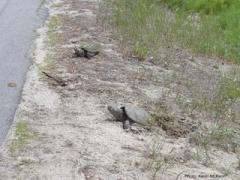Lucky Few Snapping Turtles Become Apex Predators
- July 15th 2023
- Nature
by Kevin McKeon, Maine Master Naturalist

Ranging from southeastern Canada to northeastern South America, the 40-million-year-old snapping turtle is one four species of snapping turtles, all of which live only in the Americas, and one of nine turtle species living in Maine; two of those species are marine, or sea, turtles. Ashes from ancient Wabanaki fires indicate that turtles were an important source of food, but their longevity and ability to live in poor habitats now make them prone to mercury poisoning. In Canada, anthropogenic activities have resulted in their listing as a Species of Special Concern and a Specially Protected Reptile under various laws.
Living in shallow waters of wide, muddy streams and ponds, snappers often warm their cold-blooded bodies by basking near the surface, or sometimes on logs or rocks jutting out of the water. This basking allows quicker body movements resulting in more efficient foraging activities, as they prey upon fish, frogs, snakes, small birds—just about anything they can swallow—along with various plants. They’ll sometimes eat just once a year, if they get a sizable fish! They tend to be a bit combative out of water, but in water are rather skittish, preferring to hide in the mud.

Contrary to popular thinking, the bite of a snapper generates only about half the force of ours, but the shearing effect of their beaked jaws makes up for it! Their other defense is to release foul-smelling urine when disturbed on land.
Female snapping turtles are faithful to their nesting areas, often returning to the same sandy area for nesting, and sometimes following a stream bed or ephemeral stream for thousands of yards; There’s some evidence that they use the earth’s magnetic fields for navigation. A female snapper will begin to breed when its carapace, or hard outer shell, reaches 8”; this is at about 15 years old. Sandy roadbeds make attractive nest sites, being open and sunny, easy digging, and well drained. Her nest is dug during late May to June, holding about 30-50 eggs. The temperature of the incubating eggs determines the eventual sex of the hatchlings. Within the clutch, the central eggs will more likely produce males. But, up to 90% of these nests are predated by crows, fox, mink, raccoons and skunks.
In 80 to 90 days, the young hatch. In cold climates, the hatchlings often overwinter within the nest, emerging in the late spring. When ready, the ¾” long hatchlings dash towards water, becoming prey to other hungry critters and many birds. Those that make it to the water become tasty morsels for bullfrogs, snakes, fish, otter, mink, and various wading waterfowl. So, the mortality rate of these young snappers is very high, resulting in a very low reproductive success rate for every nest. The very few lucky ones that manage to reach a mature 10 to 35 pounds could live another 100 years, becoming apex predators themselves. One huge wild snapper topped 75 pounds, and a captive one reached 86 pounds!






